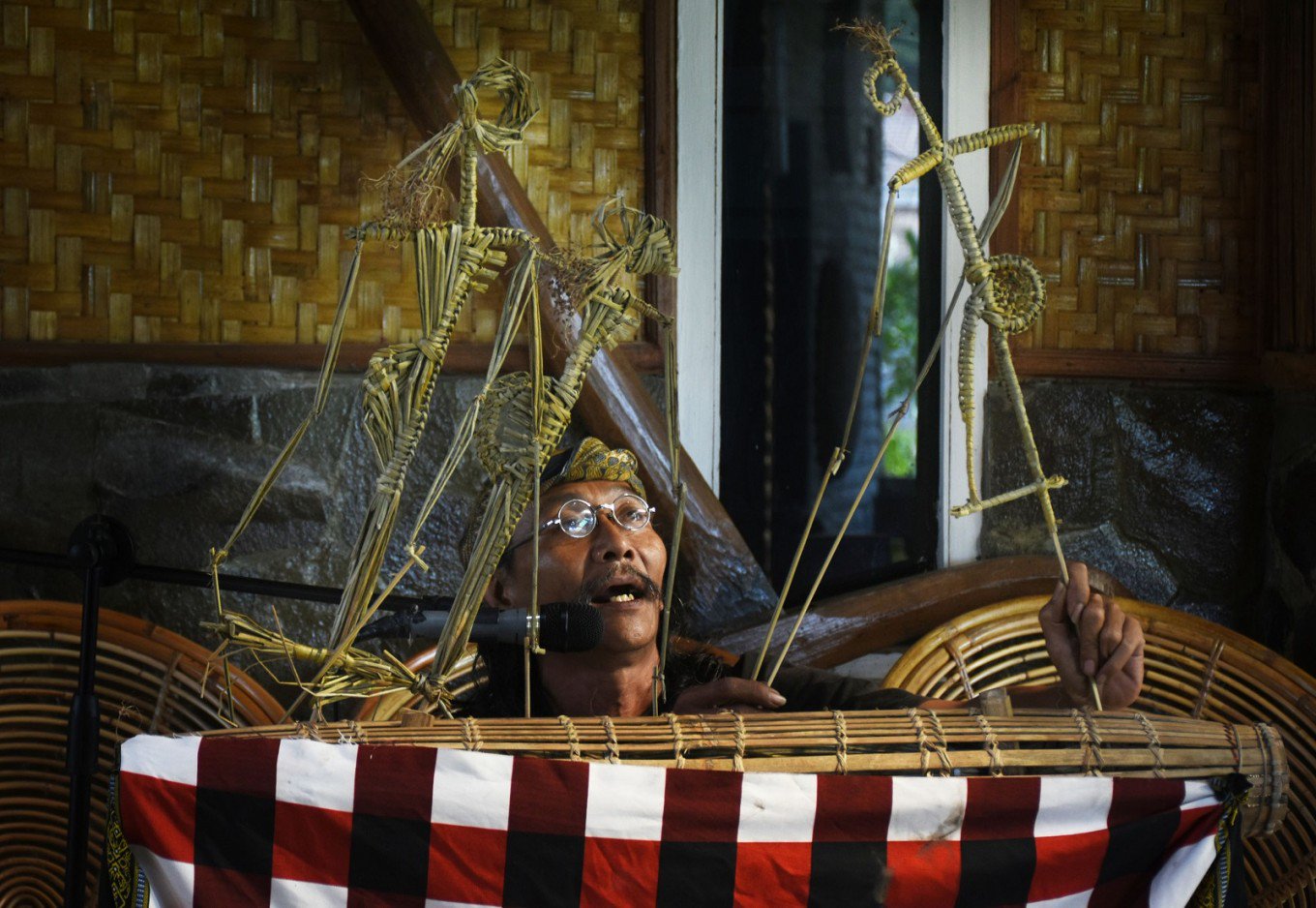
UNVEILING LESSONS OF LIFE WITH GRASS PUPPETS
Syamsul
Subakri, also known as Mbah Kardjo, was busy with a handful of dried
grass. His fingers skillfully wove the grass to form wayang suket (grass
puppets).
This
puppet master, who is also an animal rescuer, was seen demonstrating his skill
between discussion sessions at the recent launch of the book Merawat
Tradisi dan Kearifan Budaya (Nurturing Tradition and Cultural
Wisdom).
The
event was held at a coffee shop in Mejosari village, Malang, East Java. True to
its title, the book was introduced together with the presence of Mbah Kardjo,
a local artist who uses grass puppets as a tool to spread the campaign on
nature preservation, honesty, living in harmony, tolerance and social
awareness.
Kardjo
said that he named his grass puppets Puspa Salira (little bodies made of flowers).
They are usually staged between a source of light and a translucent screen, and
viewers watch the shadow of puppets in evening performances.
When
the puppet play is staged in the daytime, it resembles a stick puppet
performance. The plays could portray any stories according to the events’
theme, or the classical stories of Mahabharata and Ramayana (the two major
Sanskrit epics of ancient India).
The puppet master shows off a grass puppets he crafted himself.
(JP/Aman Rochman)
“Today,
the story is about the rich and the poor who become government officials in the
era of information technology, and they got involved in a corruption case,”
said Kardjo, who also mentioned that the city of Malang had seen many graft
cases lately.
Grass
puppets are made of mendong grass (Fimbristylis umbellaris), forming
the shapes of men and women. Puppets are usually 50 centimeters tall, supported
by bamboo rods so that they can be moved by the puppet master. Kardjo also
makes 20-cm-tall puppets, however, for performances in front of children.
The
making of grass puppets is usually the time when Kardjo delivers the Javanese
wisdom for living. He starts with making the nose, symbolizing that there are
rules to follow in order to live well; then the head, conveying a message that
humans are noble creatures; while the neck is a sign of alertness, sensitivity
and humility. The chest symbolizes the notion that humans are only made
distinctive by their good deeds, while shoulders remind of the importance of hard
work and that humans must believe that hard work pays.
The making of a grass puppet (JP/Aman Rochman)
“Minutes
dedicated to making wayang suket also teaches patience and precision,
and it trains both sides of the brain, right and left. Each grass puppet is one
of a kind. No two puppets are the same,” said Kardjo.
Read also: “Wayang kulit” craftsmanship still
flourishing in Wonogiri village
The
puppet master always makes new wayang suket for every performance, and at the
end of the show, he will distribute the puppets to the audience.
While
waiting for his turn to perform, Kardjo usually makes small puppets, at the same
time citing the meanings of each puppet’s body parts.
Through
the puppets, he delivers the message to respect differences, the importance of
tolerance and sharing. (mut)
SOURCE
: The Jakarta Post
 English
English Japan
Japan

grandma's viagra song lyrics medication to reduce libido viagra sildenafil coupon for cialis prescription alternate uses for viagra cheapest prescription prices
generic viagra legal in us online viagra cheap top class action lawsuit no proof purchase brand viagra next day delivery free prescriptions at kroger pharmacy order viagra pills online cialis samples remedies for women with no libido passport photos at cvs 5.99 drug classification chart viagras what is better than viagra and cialis sildenafil 100mg cost little blue pill for diabetes goodrx kroger viagra use viagra sample pack pink and green dresses for women pictures of generic viagra pills viagra bestellen i take red generic viagra fast shipping viagra men how much does viagra cost humalog 100 kwikpen discount card non prescription online pharmacy reviews fda approvals 2017 generic viagra pharmacy rx cialis women use cost for viagra goodrx is it a scam indian pharmacies online
brand viagra pfizer sale viagra effects on size free birthday coupons to print viagra connect walgreens ph of kroger water granuflo settlements in mass
female libido enhancers over the counter kroger purified drinking water recall viagra alternatives male enhancement reviews consumer reports viagra super active vs viagra sildefinal
what is viagra purple viagra pills 5mg cialis viagra generico fda approved drugs for adhd how quickly does viagra work does viagra really expire